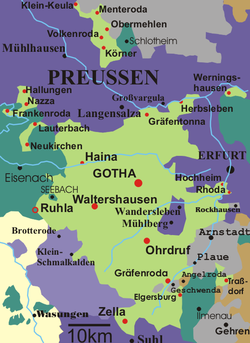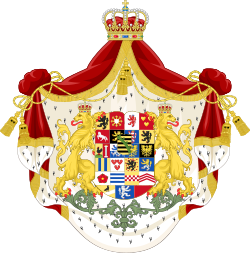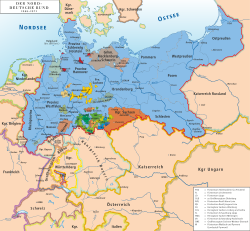Saxe-Coburg and Gotha
This article needs additional citations for verification. (January 2017) |
Duchy of Saxe-Coburg and Gotha Herzogtum Sachsen-Coburg und Gotha (German) | |||||||||||||||
|---|---|---|---|---|---|---|---|---|---|---|---|---|---|---|---|
| 1826–1918 | |||||||||||||||
Duke | | ||||||||||||||
• 1826–1844 | Ernest I | ||||||||||||||
• 1844–1893 | Ernest II | ||||||||||||||
• 1893–1900 | Alfred | ||||||||||||||
• 1900–1918 | Charles Edward | ||||||||||||||
| History | |||||||||||||||
• Established | 1826 | ||||||||||||||
| 18 November 1918 | |||||||||||||||
| Currency |
| ||||||||||||||
| |||||||||||||||
Saxe-Coburg and Gotha (
The name Saxe-Coburg-Gotha also refers to the family of the ruling
History

The Duchy was born when the arbitration of the King of Saxony, Frederick Augustus, produced the Treaty of Hildburghausen on 12 November 1826 for the Gothaische Teilung (Gothan Division), the extensive rearrangement of the Ernestine duchies. After the extinction of the Saxe-Gotha-Altenburg line, the Duke of Saxe-Hildburghausen exchanged his Duchy for that of Saxe-Altenburg. The Saxe-Meiningen line became Saxe-Hildburghausen and got from Saxe-Coburg-Saalfeld the Saalfelder territories as well as the District of Themar and the places of Mupperg, Mogger, Liebau and Oerlsdorf. The Duchy of Saxe-Coburg-Saalfeld received for that the Duchy of Saxe-Coburg, Districts of Königsberg and Sonnefeld from Saxe-Hildburghausen, and the properties of Callenberg and Gauerstadt from Saxe-Meiningen.
By then, the Principality of Lichtenberg, on the Nahe River, had already been a part of the Duchy of Coburg for ten years. Ernest III, the sovereign of Saxe-Coburg-Saalfeld, had received it in 1816 from the Congress of Vienna for providing assistance to the Allies in their war against France. But, because of the great distance from Coburg and of the unrest caused by the Hambach Festival, the Duke sold the Principality in 1834 to Prussia.
The newly created Duchy of Saxe-Coburg and Gotha was initially a double duchy, ruled by Ernest III as Duke Ernest I in a
The Duchy of Saxe-Coburg and Gotha received on 3 May 1852 a national constitution, which had taken substantial parts of the fundamental rights from the
Ernest I died in 1844. His elder son and successor, Ernest II, ruled until his own death in 1893. Because he had died childless, the throne of the two duchies would have passed to his late brother




Alfred's only son, also named
After the
Politics
In the German Empire, the Duchy had only one vote in the
Each Duchy had its own Landtag, elected every four years by male taxpayers over 25 years of age. Only males 30 years or older were eligible to stand for the elections. The Coburger assembly had 11 members and its twin in Gotha had 19. The assemblies met every year but, every two years, they would combine, alternatively in Gotha and Coburg, for the matters and questions that involve both Duchies.[10]
For both duchies, however, there was a Ministry of State in Gotha but Coburg and Gotha had their own subordinate and almost independent ministries. The Minister of State directed Gotha's Ducal ministry but, for both Duchies, he was responsible for the state affairs, the economical and commercials policies, the judiciary and the conduct of Imperial laws. In Coburg, for state matters as such as community services, police duties, support of the state church, and education, as well as management of assets and finances, and also, until 1891, court matters, the local authorities could not interfere with the decisions from Gotha.
The finances of both Duchies remained basically disconnected. But, in their management, a distinction was always made between the Crown revenue from the domains and the State revenue from taxes and duties. Every four years, a common budget, especially in the financial dealings with the German Empire, was made, even if it interfered with the local and national operations of the two Duchies. Grants from the state budgets of both Duchies were made in the ratio of 7 to 3 between Gotha and Coburg.
Because of its size and finances, the Duchy did not have ambassadors but it did have trade consuls. They were for trade with Austria-Hungary, Belgium, Argentina, Brazil, Chile, Cuba, Ecuador, France, Great Britain, Italy, Mexico, Peru, Portugal, Prussia, Russia, Spain, Switzerland, and Turkey.[9] The United States had its own consul in Coburg from 1897 to 1918.[11]
During the American Civil War, Ernst Raven was assigned to the position of consul in the state of Texas. He applied to the Confederate Government for a diplomatic exequatur on 30 July 1861 and was accepted.[12]
Military

Before 1867, the Duchy of Saxe-Coburg and Gotha had its own Army. But, on 26 June 1867, because of a treaty signed in 1866 with Prussia, its Army was added, for defending and recruiting purposes, to the 6th Thuringian Infantry Regiment No. 95 of the
Miscellaneous
The capitals of Saxe-Coburg and Gotha were Coburg and Gotha. By 1914 the area and populations of the two duchies were:[15]
| Duchy | Area | Population | |
|---|---|---|---|
| km2 | sq mi | ||
| Saxe-Coburg | 562 | 217 | 74,818 |
| Saxe-Gotha | 1,415 | 546 | 182,359 |
| Total | 1,977 | 763 | 257,177 |
There are two
-
Ehrenburg Palace, Coburg
-
Friedenstein Palace, Gotha
-
Reinhardsbrunn Castle, Gotha
-
Callenberg Castle, Coburg
-
Rosenau Castle, Coburg
Only the Duchy of Gotha, along with nearby Duchies of Saxe-Meiningen and Saxe-Altenburg and especially the Grand Duchy of Saxe-Weimar-Eisenach – was able to be one of the sponsoring states of the University of Jena. Coburg did not have its own university. It did not have its court of law, either. Gotha had its own court of law while Coburg had to go to Meiningen for the legal administration.
Ruler

Titles and styles of the Sovereign of the House
According to the Staatsgrundgesetz (House laws) of the Duchy of Saxe-Coburg and Gotha, the full title of the Duke was:[16]
Wir, Ernst, Herzog zu Sachsen-Coburg und Gotha, Jülich, Cleve und Berg, auch Engern und Westphalen, Landgraf in Thüringen, Markgraf zu Meißen, gefürsteter Graf zu Henneberg, Graf zu der Mark und Ravensberg, Herr zu Ravenstein und Tonna usw.
Translation: We, Ernest, Duke of Saxe-Coburg and Gotha,
, et cetera.Titles and styles of other members of the House
The use of Ducal and Princely titles may be restricted if the marriage conflicts with the requirements of the Staatsgrundgesetz or if a member of the House renounces his claims for himself and his descendants.[16]
Dukes of Saxe-Coburg and Gotha (1826–1918)

and Gotha
- Ernest I, Duke of Saxe-Coburg and Gotha (1784–1844) reigned 1826–1844
- Ernest II, Duke of Saxe-Coburg and Gotha (1818–1893) reigned 1844–1893
- Prince Albert of Saxe-Coburg and Gotha (1819–1861), Prince Consort of the United Kingdom of Great Britain and Ireland 1840–1861
- King Edward VII of the United Kingdom (1841–1910), reigned as king 1901–1910;
- Alfred, Duke of Saxe-Coburg and Gotha, Duke of Edinburgh (1844–1900), reigned 1893–1900
- Alfred, Hereditary Prince of Saxe-Coburg and Gotha (1874–1899), predeceased father
- Prince Arthur, Duke of Connaught and Strathearn (1850–1942)
- Prince Arthur of Connaught (1883–1938)
- Prince Leopold, Duke of Albany (1853–1884)
- Charles Edward, Duke of Saxe-Coburg and Gotha (1884–1954), reigned 1900–1918, abdicated 1918
State Ministers of Saxe-Coburg and Gotha (1824–1919)
- 1824–1840 Christoph Anton Ferdinand von Carlowitz
- 1840–1840 Dietrich [Carl August] Freiherr von Stein (first time)
- 1840–1846 Georg Ferdinand von Lepel
- 1846–1849 Dietrich [Carl August] Freiherr von Stein (second time)
- 1849–1888 Camillo Freiherr von Seebach
- 1888–1891 Gisbert von Bonin
- 1891–1900 Office Vacant
- 1900–1905 [Philipp Hermann] Otto von Hentig
- 1905–1914 Ernst [Friedrich Hermann] von Richter
- 1914–1919 Hans Barthold von Bassewitz
See also
- Ernestine duchies
- Palais Coburg in Vienna
References
- ISBN 978-0-1431-2295-1.
- ISBN 978-1-4738-4580-0.
- ^ a b (in German) Erdmann, Coburg, Bayern und das Reich 1918–1923, p. 2–3
- ISBN 3-7400-0077-5, p. 223
- ^ (in German) Dressel, Die Entwicklung von Verfassung und Verwaltung in Sachsen-Coburg 1800–1826 im Vergleich, p. 532
- ^ (in German) Jellinek, Georg, Die Lehre von den Staatenverbindungen [The Theory of the Unifications of States] (Berlin: Verlag von O. Haering 1882), p. 208 ff.
- ^ (in German) Sander, Harold. "II.1.4 Prinz Albert", Das Haus von Sachsen-Coburg und Gotha 1826 bis 2001, page 86: "Der zukünftige König von England und der vorraussichtliche englische Thronfolger sind von der von Regierung im Herzogtum ausgeschlossen" ["The future King of England and the presumptive British Heir to the Throne are excluded from the government in the Duchy"]
- ^ Fitzroy, Almeric. Clerk of the Privy Council, "The Titles Deprivation Act, 1917", The London Gazette, Her Majesty's Stationery Office, London, England, 28 March 1919, Issue No 31255, page 4000
- ^ a b c Robinson, Janet and Joe Robinson, Handbook of Imperial Germany (Bloomington, Indiana: AuthorHouse, 2009), page 87
- ^ Martin, Frederick, ed., The Statesman's Yearbook: A Statistical, Genealogical, and Historical Account of the States and Sovereigns of the Civiised World for the Year 1866 (London and Cambridge: MacMillan and Co., 1866) page 173
- ^ Lawrence Kestenbaum, “U.S. consul officials in Germany”, The Political Graveyard, retrieved 10 December 2013.
- ^ 58th Congress, 2nd Session, Senate Document No. 234, Journal of the Congress of the Confederate States of America, 1861–1865, Volume 5 (Washington, D. C.: Government Printing Office, 1905), page 422
- ^ "Militar". Das Deutsche Schutzgebiete: Herzogtum Sachsen-Coburg-Gotha [The German Protectorates: The Duchy of Saxe-Coburg-Gotha] (in German). 5 July 2017.
- ^ Martin, Fredrick (ed.). The Statesman's Yearbook 1866 (in German). p. 174.
... the finances of the duchy do not allow the maintenance of a large force, the troops required for actual service are drawn by conscription, in the form of ballot.
- ^ (in German) Sander, Harold, “I.11 Herzogtum Sachsen-Coburg und Gotha”, Das Haus von Sachsen-Coburg und Gotha 1826 bis 2001, page 27
- ^ a b (in English and German) Velde, François, "House Laws of the Saxe-Coburg and Gotha", posted 17 June 2008, Heraldica: Topics: Royalty, http://www.heraldica.org/topics/royalty/HGSachsen-CG.htm, retrieved 10 December 2013. The original source was: Paul Posener, Die staatsverfassungen des Erdballs; unter Mitwirkung von Gelehrten und Staatsmännern [The State Constitutions of the World, With Participation of Scholars and Statesmen]. (Charlottenburg: Fichtner, 1909).
Bibliography
- Dressel, Carl-Christian H., Die Entwicklung von Verfassung und Verwaltung in Sachsen-Coburg 1800–1826 im Vergleich(The Development and Comparison of the Constitution and Administration of Saxe-Coburg 1880 – 1826) (Berlin: Duncker & Humblot, 2007), ISBN 978-3-428-12003-1, Subscription required. (in German)
- Erdmann, Jürgen, Coburg, Bayern und das Reich 1918–1923 (Coburg, Bavaria and the Empire 1918–1923), Coburg, Druckhaus und Vesteverlag A. Rossteutscher, 1969, (Coburger Heimatkunde und Landesgeschichte Reihe 2, 22 (Coburger Studies of State and Local History Series 2, Nr 22), ZDB-ID 1151614-8) (simultaneously: University of Würzburg, Dissertation, 1969: Coburg in den Anfangsjahren der Weimarer Republik 1918–1923 (Coburg in the Beginning of the Weimar Republic Years 1918–1923)) (in German)
- ISBN 3-929000-78-4. (in German)
- Niclas, Thomas, Das Haus Sachsen-Coburg – Europas späte Dynastie (The House of Saxe-Coburg – Europe's Last Dynasty), Stuttgart, ISBN 3-17-017243-3. (in German)
- Sandner, Harold, Das Haus von Sachsen-Coburg und Gotha 1826 bis 2001 (The House of Saxe-Coburg and Gotha 1826 to 2001), Coburg, Neue Presse GmbH, 2004. ISBN 3-00-008525-4. (in German)
External links
- The Ducal House of Saxe-Coburg and Gotha – the official website of the house (in German and English)
- The Catholic Encyclopedia: Saxe-Coburg and Gotha – article about the Duchy, written in 1910, with details about the religious issues (in English)
- Chisholm, Hugh, ed. (1911). . Encyclopædia Britannica (11th ed.). Cambridge University Press. (in English)











